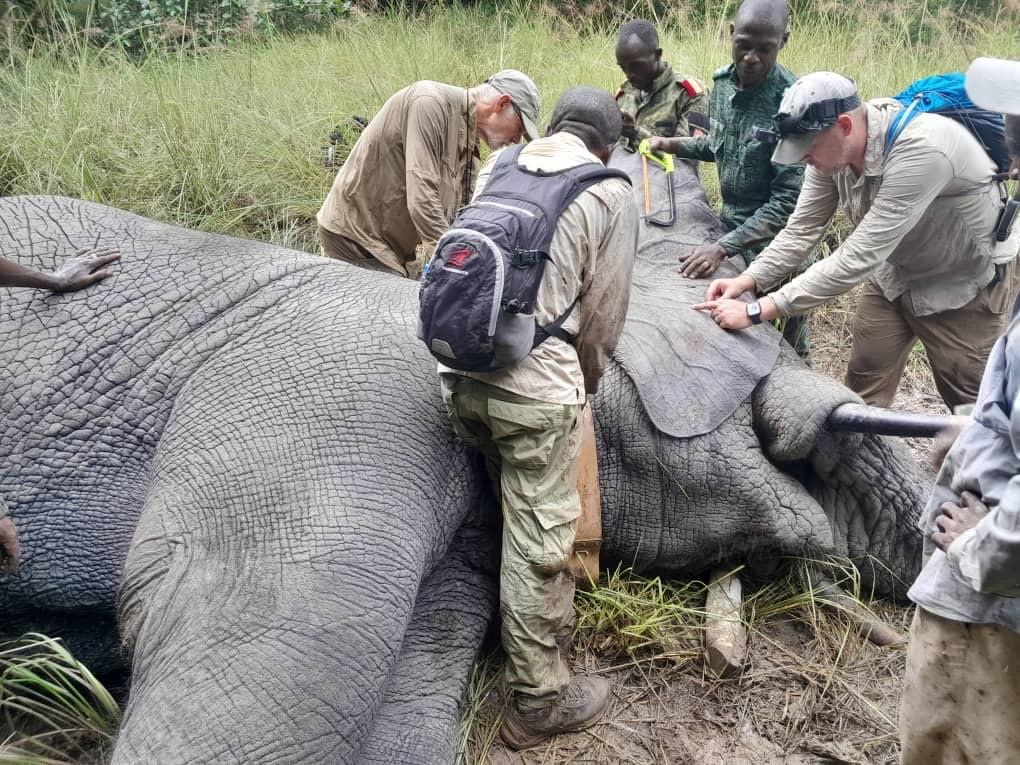In the Company of Giants
Dr. Tim Georoff shares a behind-the-scenes look at his work tracking and protecting elephants in West Africa

Dr. Georoff and team placing satellite collar on anesthetized forest elephant
For most of us, a trip to Africa conjures images of safaris, sunsets, and perhaps an elephant seen from the safety of a tour vehicle. For Dr. Tim Georoff of Sedgefield, the experience is far more personal—and far more demanding.
A veterinarian at the North Carolina Zoo, Dr. Georoff has spent close to two decades caring for animals of all kinds, from fish to reptiles to birds. But his recent work has taken him far beyond the zoo walls, deep into the tropical forests and savannahs of Côte d’Ivoire, West Africa, where he assists in efforts to protect and monitor the region’s elephants.
“I probably go all the way back to being a little kid,” Tim says of his lifelong passion for wildlife. “I wanted to work and positively impact wildlife in wild places.”
From Zoo to Field
That early drive led him to a career as a zoo veterinarian, and eventually to the North Carolina Zoo, which has long been involved in elephant conservation. The Zoo’s former Chief Veterinarian, Dr. Mike Loomis, began work in the 1990s placing satellite collars on elephants in Cameroon in partnership with the World Wildlife Fund. The collars helped anti-poaching efforts and guided land management strategies. Tim joined the zoo in part because of this ongoing project, which has since expanded to include forest elephants in Côte d’Ivoire.
Unlike the savannah elephants familiar to many from documentaries or safaris, the forest elephants of West and Central Africa are a distinct and elusive species. “They are smaller and typically inhabit a forested landscape,” Tim explains. “While I've provided medical care for elephants in zoos for many years, I'd never worked hands-on with this species until this work.”
Tracking these elephants isn’t simple. The team collaborates with Ivorian government agencies and relies on local trackers to locate herds, often hiking 15 to 20 miles a day on foot. When a suitable elephant is found, Dr. Georoff’s role comes into focus.
“We provide assistance anesthetizing elephants and placing satellite collars,” he says. “Anesthetizing large mammals requires specialized training and equipment. The elephants we are working with typically inhabit resource-poor or heavily forested areas that are not easily accessible by car or aircraft.”
With an elephant under anesthesia, the team works quickly, collecting samples to assess health and expand scientific understanding. They also train local rangers and veterinarians in these methods, building long-term conservation capacity in the region.
On the Ground in Côte d’Ivoire
The work spans many corners of the country, from degraded forests and plantations near villages—where elephant-human conflict is common—to remote rainforest reserves.
“The conditions can vary quite a bit depending on whether we are working in the rainy or dry seasons,” Tim says. “Often, we’ll set up camp in a nearby village or in a field location close to where there are signs of elephant activity.”
It’s a rugged and physically demanding environment. The terrain is difficult, the climate hot, and the hazards many—venomous snakes, biting insects, and the elephants themselves, which can be unpredictable and dangerous.
“Seeing this firsthand gives you a different appreciation and respect level,” he says. Bull elephants in musth, a period marked by elevated testosterone, and protective females with calves pose particular risks.
One moment, in particular, left a lasting impression. “The first time I was able to touch an anesthetized forest elephant was a surreal experience,” he recalls. “To be so close to such a powerful and rare animal—it’s not something you forget.”
Back Home and Looking Ahead
Tim’s commitment to conservation doesn’t pause when he returns home to Sedgefield. “Our work is ongoing,” he says, “and we have additional work tentatively planned over the next year.”
Juggling conservation work with his responsibilities at the zoo—and at home—is no small task. “We have two young girls, 12 and 8, who are involved in a myriad of activities,” Tim says. “Balancing that with this work and my day job...and my wife's, who also has a serious job and career of her own, can be challenging.”
But the effort is worth it.
“This isn’t ecotourism,” he says bluntly. “This is incredibly hard and dangerous work. Conditions are very hot and full of hazards. You have to enjoy—or at least be able to tolerate—long periods without a comfortable bed, clean laundry, air conditioning, or many other creature-comforts. And be physically fit to handle long, strenuous hiking.”
Despite the discomfort and danger, Dr. Georoff sees the work as essential.
“At the end of the day, I am reminded about the importance of the work’s impact to preserve wild elephants and elephant habitat.”